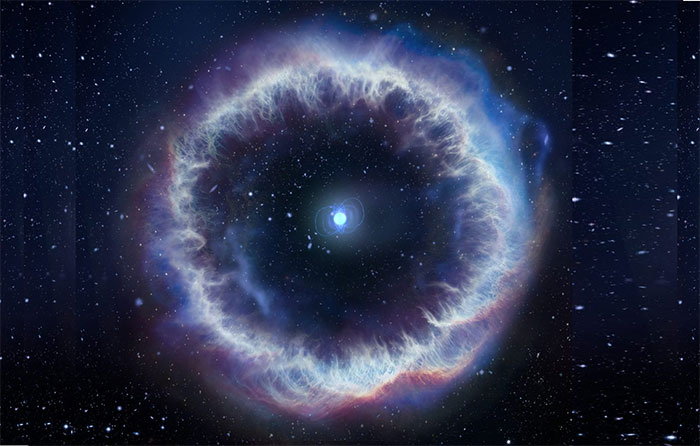America catches strange signal from 1.3 billion light years away from Earth
The faintest radio burst ever detected by humanity could help solve the long-standing mystery of this spooky cosmic signal.
A new study led by the Italian National Institute for Astrophysics (INAF) has found the origin of the strange signal coded FRB20201124A , which was picked up by the world's most sensitive radio telescope, the Very Large Array (VLA, located in the US).
The mysterious object sending the signal was not a black hole merger, neutron star or alien technology, but one of the most beautiful and spooky structures in the universe.

A magnetar and the beautiful nebula around it may be the source of a powerful and mysterious radio signal that regularly disturbs Earth's observatories - (Graphic: NSF/AUI/NRAO)
According to SciTech Daily, FRB20201124A is a radio burst , the most curious type of astronomical signal for scientists.
They are emitted within just a few milliseconds, but release a huge amount of energy, one of the highest energies observable in cosmic phenomena.
That's also why FRB20201124A can reach Earth's observatory even though its source is 1.3 billion light years away.
Because of its great distance, FRB20201124A in the VLA data is also very faint, arguably the weakest radio burst ever recorded.
However, it has helped astronomers create a groundbreaking model that could help explain the common origin of radio bursts.
The most plausible thing that could have produced FRB20201124A is a giant bubble of plasma, possibly created by the continuous radio emissions of a magnetar or a highly dense X-ray binary star system.
This bubble forms a beautiful, ghostly nebula, whose "core" is an active magnetar, visible in the light collected by radio telescopes, if we are close enough.
Magnetars are also neutron stars, but they are an extreme form of neutron star, much more powerful than regular neutron stars.
Neutron stars are the remains of "dead" giant stars, small but energetic.
Meanwhile, a highly accretive X-ray binary system would consist of a neutron star or black hole, accreting matter from a companion star at a very rapid rate.
The detailed study, published in the journal Nature, involved researchers from Italy, China, the United States, Spain and Germany. However, the authors say understanding the possible origins of radio bursts is just one more piece of the puzzle in solving the larger puzzle of the nature of these mysterious cosmic signals.
- Strange phenomenon in South America: Earth is about to reverse?
- Bad news about 'alien signal' from 4.2 light years from Earth
- Asia will crash into America
- What color is the turn signal light? It's easy to think but 90% of people answer wrong
- Mysterious repeat radio flash, 3 billion light-years from Earth
- The US produces about one billion light-years of sunlight
- Earth catches strange radio signal flashing from the 'monster' black hole
- Obtain a strange signal that can be emitted by aliens
- Strange signals from the star are 11 light years from Earth
- The Australian Observatory caught the most unusual radio signal
- Detect suspicious signals of aliens from more than 230 stars
- Spacecraft catches strange signal: New record for 'space death'!
 Van Allen's belt and evidence that the Apollo 11 mission to the Moon was myth
Van Allen's belt and evidence that the Apollo 11 mission to the Moon was myth The levels of civilization in the universe (Kardashev scale)
The levels of civilization in the universe (Kardashev scale) Today Mars, the sun and the Earth are aligned
Today Mars, the sun and the Earth are aligned The Amazon owner announced a secret plan to build a space base for thousands of people
The Amazon owner announced a secret plan to build a space base for thousands of people